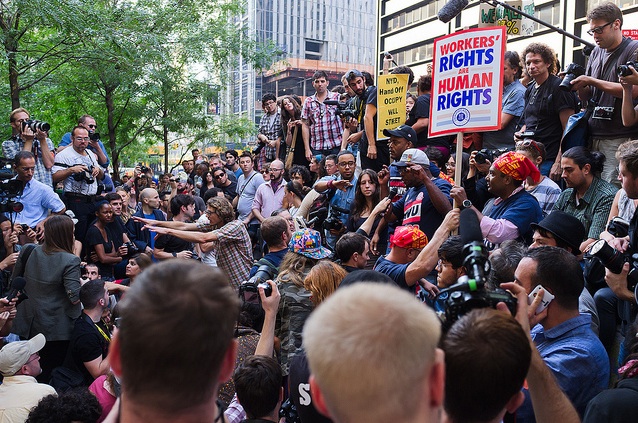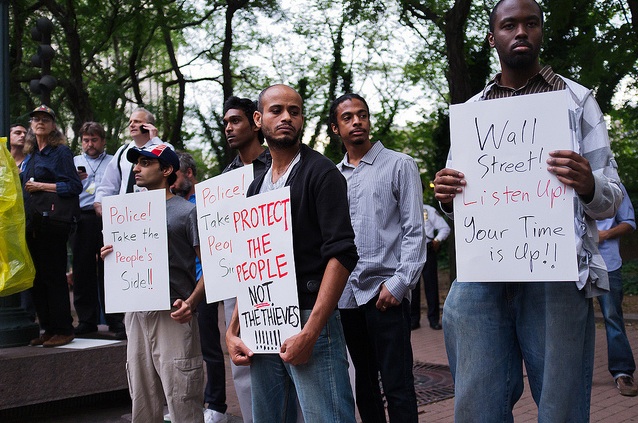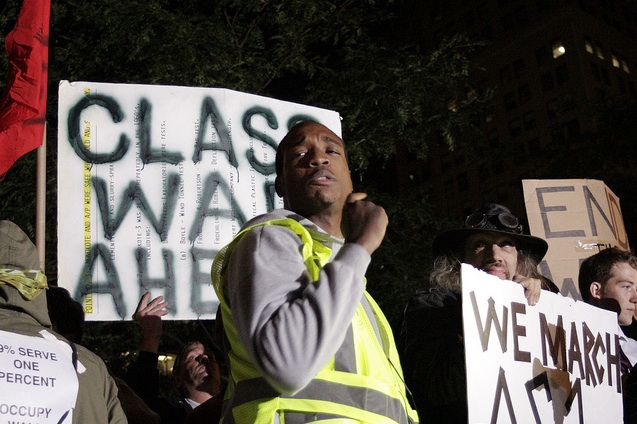by Stephanie Luce
October 7, 2011
Picking up where we left off?
It was a strange feeling to be in Zuccotti Park (once called Liberty Plaza Park), right next to Ground Zero. I was with thousands of people listening to speeches through the “people’s microphone.” The crowd looked so similar to those of the late 1990s/early 2000s “anti-globalization” movement – and we used that method for communicating then too. Things had gone poorly in April 2000, when most of the big unions decided to lobby at the Capitol against Permanent Normal Trade Relation (PNTR) status for China, while on the other end of the mall thousands of young people were blocking streets attempting to stop the IMF and World Bank meeting. Despite some common ground built in Seattle, we were a ways off from a real alliance between the labor movement and the other burgeoning environmental, student, anti-imperialist movements.
It seemed like things were beginning to change, however. In the summer of 2001 the AFL-CIO put someone on staff for several months to build labor participation for the coming IMF/World Bank meetings to take place that fall. People were mobilizing around the country, and the world, to build a common movement against neoliberalism and “structural adjustment.” The weekend of September 6-9, 2001, over 1000 labor and community activists convened in Cleveland for the Jobs with Justice conference. Spirits were high, and there was a real sense that the world was about to change.
Little did we know how it would change. Only two days later were the 9/11 attacks. And suddenly the movement we had been building collapsed.
It has taken ten years, but the scene at Occupy Wall Street (OWS) seems to suggest we’ve rebuilt what we had been building then. OWS was started by a group of mostly young people, seemingly unfocused, seemingly mostly white, seemingly not very strategic. But whatever they were they created a space that was flexible enough to allow others in. That hasn’t happened smoothly in all cases, and certainly is not yet enough, but anyone who goes to Zuccotti Park seems to feel the same thing. A sense of exhilaration at the audacity, the feeling of freedom and possibility.
TWU Local 100 was the first union to endorse Occupy Wall Street. Individual members had already been participating in events at Zuccotti Park, but the unions were absent. Local 100 took a bold move to come out early in support of a movement that was still hardly covered by the media, and mostly denounced as a fringe circus. Once Local 100 endorsed, the flood gates opened and unions and community groups jumped on board. Many have endorsed a large community/labor march in New York. Others not based in New York have expressed general support for the Occupation (such as the Steelworkers).
Quickly the Beyond May12 coalition helped pull together a labor/community march in support of the Occupation, and with less than a week’s notice, got most of the city’s largest unions on board, and pulled off one of the largest marches we’ve seen in the city for some time.

Photo: Mat McDermott
Where did this come from?
Some writers have suggested that OWS sprang from nowhere, completely spontaneously. That is somewhat true, but misleading. As I said, the movement is in some ways picking up from where we left off before 9/11. But in other ways, this is just one moment in a series of fightbacks that has been going on for awhile, particularly since the economic recession hit. You wouldn’t know it from mainstream media sources, but there have been an incredible number of protests over the past few years, involving large numbers of people. Of course there was Wisconsin, but there have also been large scale strikes (e.g., Verizon, nurses, longshore), hunger strikes and prison organizing (e.g. Pelican Bay, Georgia), environmental justice protests (e.g Tar Sands), foreclosure fightbacks, bank protests (New Bottom Line), economic justice rallies (One Nation), immigrant rights campaigns (the DREAM Act) the US Social Forum, which had 15,000 people plus numerous large scale marches, and more.
Then there are the international protests – the Arab Spring, Greece, Portugal, Spain, China, London, South Africa, Benin, Brazil, and more. While the US is often US-focused there is no doubt that protests elsewhere have inspired and motivated many here. The idea that resistance is possible, and that fightbacks can win, helps put more people into motion.
As social movement scholars show, we don’t know which of these protests will be the one to spark a larger movement. We try and try, and lose a lot, until one time it sticks. Occupy Wall Street is clearly building off the momentum of resistance seen around the country and world over the last few years, and tapping into the memory of where we were ten years ago.

Photo: Mat McDermott
We are all Troy Davis; We are all Sean Bell
Occupy Wall Street started out small and got little attention. It is possible it would have fizzled out as people went home. But four days into the occupation, Troy Davis was executed by the state of Georgia. This provoked outrage across the country, including among many at OWS, who joined in with others out to protest the execution. This brought new energy, as many people were feeling outraged and disempowered by a racist legal system.
The connection was strong in New York, where protestors have long pushed around by the police. Anyone who has been to a march in this city knows that at least since 9/11, but perhaps since Seattle, the NYPD has used aggressive tactics to keep control over protests. Barricades are used to channel people into narrow spaces, separating marchers from supporters, and often breaking marches into pieces. I’ve been in that situation a lot. In 2002 we were protesting the World Economic Forum meeting in New York. The police continuously stepped into the line of the march with barricades, breaking us into pieces, and pushing us around. At one point they barricaded us from both ends of a block and began pushing. I was in the front, and suddenly a line of NYPD were shoving barricades into my stomach. When I tried to attend the massive anti-war protest on the eve of the Iraq War, I and thousands of others never made it to the actual march because police would not let us enter the street where the march took place. They had cordoned off major parts of the city, giving protestors confusing and sometimes incorrect information about how to enter.
These tactics are alienating and disempowering, and seem a complete violation of our Constitutional rights, but of course are nothing in comparison to the daily harassment of people of color in this city. That ranges from the infamous “stop and frisk” to violent arrests and sometimes death. There are already groups fighting police brutality in New York, and in the early days of OWS and after Troy Davis was executed, some OWS protestors marched through streets chanting, “We are all Sean Bell, NYPD go to hell.” Saturday, September 24, the forces merged in a spontaneous march, and this is when the NYPD took action, beating and arresting people. When the news broke about the police attacks on peaceful protestors, a lot more people started paying attention to OWS. A large spark that moved the OWS from a small protest-as-usual into this larger phenomenon was this intersection. The Troy Davis execution made clear to many of us just how powerless we are.
But what are the demands?
Many on the left have expressed frustration at the lack of concrete demands coming out of OWS. This surprises me a bit, because it is one of the things I find so liberating. Often, when we make demands in our struggles they immediately limit us to the short-term and winnable. Our demands certainly tend toward the least common-denominator and the pragmatic. I understand why that is the case: it builds a broader base and it puts in place something we might win. But it limits us.
Some people point out that the uprising in Egypt started with a concrete demand. That is true. But the demand that “Mubarak must go” is so much less than the demand “Change the system.” I’m not suggesting that “Mubarak must go” was the wrong demand for the time and place, and the victory of this was incredible. But here we have a moment to dream big.
Even in Wisconsin, much of the demand got framed as “reasonable.” We’ll agree to your concessions if you let us maintain collective bargaining. This “message” polled well, but again, it limited our imagination.
The effects of capitalism, racism, patriarchy, and imperialism go wide and deep. They interfere with just about every aspect of our lives: the way we work, the way the economy runs, how families are structured, citizenship and rights, police brutality, environmental destruction, the human life span, what we eat. Occupy Wall Street has left open a space for us all to feel we are a part of the movement. If the demands were already set many of us might feel outside – that there wasn’t a place for us, that we couldn’t dream about our issue, that we had to stay “on message.” Our fightbacks are so often balkanized and diffuse. Occupy Wall Street feels exciting in part because it doesn’t force us to choose, to prioritize. We have a few weeks when we don’t have to reduce our dreams to a slogan on a flyer. Where else do we get to chant “We are all Sean Bell,” “Tax the rich,” “End foreclosure,” “Democracy now!” and “We got sold out, Banks got bailed out” all in the same afternoon?

Photo: Timothy Krause
In the meantime, we push the organizations we belong to clarify and step up their demands. Just about all of them tie into the spirit of OWS, and there is no reason why we can’t continue to push in those arenas where we all work on a regular basis. OWS allows us to be more bold and militant in our demands that we are already working on, whether that is student loan forgiveness, a millionaire’s tax, single payer health care, ending the wars, ending the death penality, expanding immigrant rights and protecting the rights of workers to organize.
True: we don’t have real forces pushing for greater change: public ownership and democratic accountability of the Federal Reserve; federal jobs programs to hire more teachers and health care workers; repeal of NAFTA and other trade agreements; and serious reforms to the political system. We need those. Hopefully Occupy Wall Street will finally create some political space to grow the organizations required to build the real alternatives.

Comments
4 responses to “More Observations from Occupy Wall St.”
I agree with all of the commentators about the importance of OWS– although I tend to think that clear demands are crucial if the movement is to survive and grow. However, the veterans of Bloombergville and NYers Against Budget Cuts (NYABC) are NOT in the leadership of OWS. While some did attend some of the planning meetings, they did not provide leadership. In fact, many of the B-ville and NYABC folks– especially those in organizations (Solidarity, ISO, Organization for A Free Society) have been frustrated with the General Assembly, where consensus has allowed small minorities to block decisions supported by large majorities. Instead, they have focussed their energy on the Labor-Community Outreach Committee, which bears a great deal of responsibility for winning TWU 100’s support– and with it many of the other major NYC unions– for OWS. The unions’ involvement has played a big role in giving a clear, left-wing political direction and demands (tax the rich, etc.) to OWS– marginalizing the right-wing populists (Ron Paul supporters, LaRouchites, etc) who were present at the beginning of OWS.
Thanks Binh – I should have mentioned Bloombergville and Beyond May 12.
What most of the far left is missing in the Occupy America movement is the super essential importance of the FORM of the struggle: mass assemblies where those in struggle debate and discuss the way forward. This is what real free speech looks like. This is what real democracy looks like. This is what our version of social governance looks like. This is the proto-generic form of social power being made manifest.
The vanguard activists are showing the way. The far left’s responsibility is to popularise this form of struggle, and to ask questions (real ones, not “Socratic” ones) of how to link and spread these assemblies not only geographically, but in work places, social spaces and even in the tent cities, the “Obamavilles” which are sprouting up at the edge of every major city in America.
In a certain sense this is McLuhan’s vision of the media where the medium IS the message. And what a message it is.
The core of the OWS organizers were involved in the Bloombergville actions and New Yorkers Against Budget Cuts.
Far left groups have been talking about vanguards forever. Well, this is it. OWS is the vanguard, mobilizing and leading ever-greater numbers of oppressed and exploited people. Today they had a feeder march of Haitians declaring, “Don’t occupy Haiti! Occupy Wall Street!”